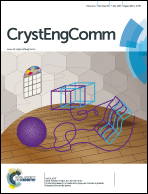Ba3(PO4)2 hierarchical structures: synthesis, growth mechanism and luminescence properties
Abstract
Europium ions-activated flower-like Ba3(PO4)2 phosphor samples with assembled nanoplates were prepared by a facile synthesis route. X-ray diffraction patterns confirmed the single crystal structure with a rhombohedral phase. The synthesis mechanism of these hierarchical structures was explained from scanning electron microscope images taken at different growth times. Transmission electron microscopy was performed to further examine their crystallinity and the structural properties were also studied by Fourier transform infrared spectroscopy analysis. The optical properties were investigated by analyzing the photoluminescence (PL) excitation and emission spectra of the samples. The PL emission spectra showed red emission of trivalent europium (Eu3+) ions along with blue emission due to the reduction of Eu3+ to its divalent (i.e., Eu2+) state. The cathodoluminescence spectra of the samples were almost similar with the PL spectra without any acute changes.


 Please wait while we load your content...
Please wait while we load your content...